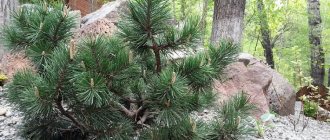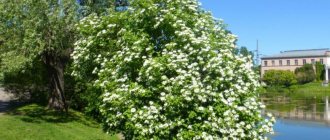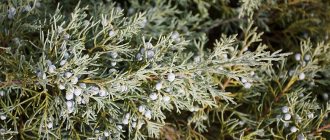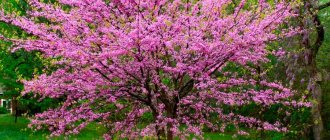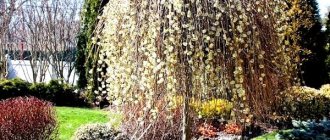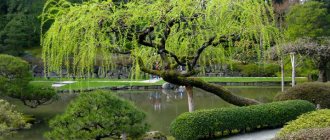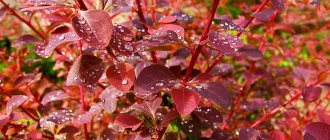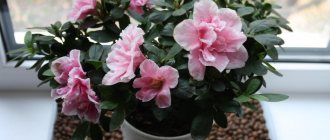There are about 100 species of pine trees in the northern hemisphere, and just over 50 species and decorative forms are cultivated. But the most popular among landscape designers is mountain pine, or mugo (Pinus mugo, p. montana), a plant native to Western Europe. This is a tree or large, highly branched shrub with creeping and ascending trunks up to several meters in height. In cultivation, at the age of 20 it grows up to 2–5 m. Short, hard and dense needles are slightly twisted, dark green in color. The cones are gray-brown, shiny, 5 cm long, ripen within 2 years, open at the beginning of winter.
- Popular varieties and forms of mountain pine Gnom variety
- Golden Glow variety
- variety Carsten, Carsten Wintergold
- variety Columbo (Columnaris)
- Humpy variety
- variety Kobold
- variety Mughus (var mughus)
- variety Ophir
- Picobello variety
- variety Varella
- Winter Gold variety
- Winter Gold variety
- variety Winter Sun
- variety Zundert
Characteristics
Species: PinusMugo
Lighting: Full sun. The tree should be rotated from time to time (if grown in a pot or container) to ensure that all parts of the pine tree receive enough light.
Temperature: Freezing down to -10 degrees Celsius is allowed, but the roots must be protected.
Watering: May dry out between waterings. Rapid soil drainage is appropriate to avoid root rot. In summer, it is necessary to spray the needles with water daily.
Feeding: Gardeners recommend feeding coniferous plants once a month in spring and fall, using slow-release organic fertilizers. If the preference falls on fertilizing with chemical fertilizers, it is worth doing this once every two weeks with a weak solution of fertilizer intended for acid-loving plants.
It is best to stop feeding for two months during the hot part of summer (July and August in the northern hemisphere). Do not feed if the tree is sick or has recently been replanted (within 2-4 weeks).
Description of culture
Pine (botanical name Pínus) is an evergreen tree, one of the most ancient species of the conifer family. Fossil remains of this representative of the earth's flora were discovered in sediments of the second period of the Mesozoic era.
Pinus is a monoecious plant. Its shoots, like other representatives of conifers, are of two types: on long leaves they have a scaly shape, on short ones they have a needle-like shape. Male flowers in the form of spikelets are located in the axils of the leaves, ovoid, scaly female cones are formed at the tips of young shoots. The seeds of most species are winged, ripen in 1.5-2 years, and, when spilled, can be carried by the wind for tens and hundreds of meters.
Some varieties of dwarf pines do not bloom or produce seeds; their main method of propagation is cuttings.
Pine is a medicinal plant known for many centuries, and all its parts have healing properties. The resin was included in the embalming compositions of the pharaohs of Ancient Egypt; analgesic and disinfectant compresses and poultices were made from infusions of pine needles. In modern medicine, pine needles, young buds and oleoresin (turpentine) are used - a resinous mass that is released when the bark is damaged. They contain disinfecting essential oils and resins, carotene, vitamins B and K, ascorbic acid, flavonoids, and tannins.
In many countries, pine is considered a magical tree endowed with magical powers. In China, Japan and Vietnam it is called the Tree of the Gods, a symbol of longevity, bringing happiness and averting troubles. It was customary to plant this plant near the palaces of emperors, and today decorative pines decorate almost every Japanese garden and Chinese garden composition.
Pruning Mountain Pine
Initial pruning should be done simultaneously with replanting. When replanting, be sure to inspect the root system so that the needles take root well. Subsequent pruning can be done in early autumn.
To maintain a suitable shape, you need to “pinch” the plant, shortening new shoots (candles) in the spring by two-thirds, before the needles open.
It happens like this:
The candles are plucked in two stages, first you need to remove the strongest and thickest candles, and after a week or a week and a half, the weaker ones. In autumn, it is recommended to reduce the number of buds on each branch to two to encourage branching. Also in the fall you need to thin out the needles, removing those that are too long or growing downward.
Thinning should be more at the top of the tree and less at the base to maintain an attractive and healthy appearance of the plant. This will also allow light to reach the lower branches and slow down growth at the top.
If the mountain pine is completely healthy, you can remove all new candles after a year before they harden. Next fall, buds will appear where the candles were removed. This reduces the appearance of knots and promotes the growth of denser needles.
Coniferous trees: general information
Conifers are one of the divisions of the plant kingdom, represented by trees (most often), as well as shrubs and dwarf trees. They grow almost all over the globe, but dominate only in one natural zone - the taiga. Two main distinctive features of this squad:
- The leaves are usually presented in the form of long thin needles.
- Seeds develop in specific shoots - cones.
Conifers are the oldest group of plants on Earth. Their remains are found in different parts of the planet and date back to 60-300 million years ago. Some of them have already died out without a trace, such as Volciaceae or Cordaite. The features and appearance of these plants can only be judged from the discovered fossil fragments.
Transplanting a plant
If the needles grow in a container, it is worth replanting them in early spring or late summer every 2-3 years for young specimens, and every 3-5 years for older ones.
When caring for seedlings, you need well-drained soil, so you will need a fairly large container or a really deep hole for the tree planting site. 50% soil and 50% coarse sand is ideal soil for Mountain Pine.
Pine trees and other conifers grow with a symbiotic fungus that grows in the tree's root ball. If this fungus is not present, the tree may die.
For this reason, pines and other conifers should never be bare-rooted unless steps are taken to reintroduce the fungus to the replanted plant, such as making a slurry (liquid mud) from the old soil and pouring it over the newly potted plant. plants.
Some experts believe that it is more important to be sure that the tree always has a healthy root system with sufficient feeding roots than to worry about symbiotic fungi.
They believe that trees are more likely to die because their root systems are too weakened right away than because there is no fungus present. Of course, in any case, you should make sure how correctly the Mountain Pine is planted and what condition its roots are in.
Appearance
Mugus pine is a plant with hard, dark green needles, individual needles of which reach 4 cm. The needles last no more than 8 years, then they are replaced by spectacular cone-shaped cones of the same length.
The shape of the crown itself is spherical, directed upward, although there are types of mugus that are capable of spreading along the ground, expanding.
As a tree, pine is no higher than 7 m, but as a shrub it is one of the tall ones and can reach 5 m, standing out significantly against the background of lower bushes. This must be taken into account when choosing a place to plant it.
There are, however, species of this shrub that are shorter in stature, not exceeding half a meter to a meter. They are distinguished by exceptionally lush and long needles and, without exception, they all have a spherical crown shape.
Pests
Bark beetles made small holes in the tree, scattered up and down the trunk. Stressed trees are more susceptible to attack. The holes look like holes. It is worth regularly inspecting the trunk of the needles.
Sawfly larvae caterpillars vary in color but usually feed in groups on needles. Sawflies can cause branches to fall off quickly if left unchecked.
Spruce mites damage older needles and are usually active in the spring and fall. Mites cause yellowing or dotting of old needles.
Zimmermann pine moth larvae burrow into the trunk. The only external symptoms may be the death of parts of the tree or masses of hardened resin on the branches.
Larvae of pine weevils. The first symptoms are pearly white drops of resin on the main branches.
Habitat
Under natural conditions, uncinata can grow in mountainous areas at an altitude of 800–2300 m above sea level. This tree is often called Pyrenean, because it is found in the Alps and Pyrenees.
Important! When planting a pine tree on a site, choose a sunny place with light, slightly acidic soil, which allows air, water and heat to pass well to the roots.
In the mountains, uncinata grows in places such as:
- gentle slopes;
- landslides;
- cracks;
- peat bogs.
Diseases
Root rot, poor watering and freezing can cause landscape pine trees to die out.
It is recommended to monitor the health of trees and prune infected branches. Otherwise, the needles turn yellow and fall off, and the main branches dry out.
Mountain pine is completely easy to care for. It will be a good decoration for the garden; you can use it as a “background plant” or as an accent in some areas of the garden. With proper care, watering and pruning, the needles will please the eye for a long time.
Coniferous trees: examples
Typical representatives of the coniferous order:
- yew;
- sequoia;
- pine;
- spruce;
- cypress;
- larch;
- cedar;
- juniper;
- fir.
Of all the listed plants, spruce, pine and larch are most often found in Russia. Where do these trees grow?
- Spruce is widespread in Europe, Asia and North America, and is widely represented in the vastness of Siberia and the Far East.
- Pine has filled the temperate latitudes of Europe and Asia; it also grows in Southeast Asia and North America (from Alaska to Yucatan).
- Larch occupies vast areas in Russia, in particular in its Siberian and Far Eastern parts.
So, we found out where pines, spruces and larches grow. Next, we will dwell in more detail on the botanical description of pine, talk about the distribution and main types of this tree.
Photo of mountain pine
Landing
Cuttings cut from a tree take root poorly, so it is not possible to grow a new specimen from them. Uncinata can be propagated by grafting yourself, but this method is quite labor-intensive and requires some experience from the gardener. The essence of the method is that a cut young pine shoot is grown onto another coniferous tree. At home, the branch does not always take root on the rootstock, so to grow uncinata on the site, the easiest way is to buy ready-made seedlings in a specialized store.
Uncinata pine planting can be done any time from March to November. But in order for the seedlings to better adapt to a new place, it is not recommended to plant them less than a month before frost. A distance of at least 4-5 m is left between adjacent specimens.
Important! You can independently collect and plant seeds obtained from pine cones. But at the same time, the resulting tree loses the characteristics of the mother specimen and may differ significantly from it in appearance.
Step-by-step instructions for planting coniferous crops:
- Prepare the planting hole 10–14 days before planting the pine on the site. The diameter and depth of the hole should be 2 times larger than the earthen ball around the roots of the seedling.
- Mix the soil obtained from digging a hole with peat and river sand in a ratio of 3:1:1. Add 25 g of complex fertilizer for coniferous crops.
- Place a layer of drainage 10–15 cm thick on the bottom of the hole. To do this, you can use pieces of broken brick, pebbles or expanded clay.
- Sprinkle some of the previously prepared nutrient soil mixture onto the drainage.
- Lower the bottom of the seedling into the hole, keeping the earthen ball around the roots of the tree. The root collar should be flush with the soil surface.
- Fill the hole with fertile soil, periodically compacting it with your hands to eliminate voids.
- Form a tree trunk area around the young seedling, enclosing it with an earthen border 2-3 cm high.
- Water the pine tree thoroughly to keep the soil moist. After the water has been absorbed, mulch the ground around the trunk with peat.
Reproduction methods
If there is already one mature mountain pine tree on the site, then getting a few more will not be difficult, the main thing is to learn how to properly propagate the mother plant. This can be done in one of two ways: by seed or by cuttings, while observing a number of requirements for the procedure.
Important! The first cones appear on pine trees only in the eighth year of cultivation, so if you need the plant purely for decorative purposes, it is better to buy mature seedlings, about 5 years old.
Seeds
The ability of mountain pine to reproduce by seeds is deservedly considered the most acceptable option for obtaining new, beautiful and healthy plants at home. If the procedure is performed correctly, all seedlings will retain their parental characteristics and will be highly decorative.
The step-by-step growing process will look like this:
- To begin, prepare the seedling boxes by arranging drainage holes at the bottom and filling the containers with a suitable soil mixture (the optimal solution is a light and loose substrate from the natural habitats of mountain pine, lightly sprinkled with peat on top, which protects future plants from the development of fungal diseases).
- Dip the prepared seeds into the Fitosporin or Fundazol solution and leave there for 10–20 minutes. for disinfection.
- Move the planting material into the prepared soil, deepening each seed no more than 0.5 cm (you can simply scatter them on the surface of the ground, only lightly sprinkling them with the remaining soil). Be sure to leave 5 cm of free space between the “neighbors.”
- Spray the plantings with water from a spray bottle, cover the box with seedlings with plastic wrap and leave in a warm place.
- The first shoots will appear in 14–20 days, after which the film can be removed and the young shoots can be watered, continuing to regularly perform this procedure using a spray bottle.
- Well-rooted seedlings are moved into open ground no earlier than 1-2 years after sowing, without exposing the root system when planting.
On the issue of the need to stratify pine seeds before planting, gardeners cannot come to a consensus, and while some consider exposure to cold to be a good incentive for the rapid germination of sown planting material, others argue that such treatment only increases the likelihood of molding of the seeds.
Did you know? The owner of the longest needles among its pine “relatives” is considered to be a swamp variety of tree, with needles up to 45 cm in length.
However, if you do not want to take risks, you can simply dry the seeds extracted from the cones well in room conditions, and then, to hatch the sprouts, move them to a humid environment for about 5 days (just wrap the seeds in a damp cloth, regularly checking their condition and preventing the appearance of mold).
If you still decide to stratify the planting material, then after soaking in water, mix the seeds with sand (in a ratio of 1:3) and send them to a cellar with zero temperature for another week, after which all that remains is to sow them in prepared boxes.
Cuttings
Cuttings are a widely used method of propagating many garden trees, so it is not surprising that it is also often used when growing mountain pine. Usually this procedure is carried out in the spring, choosing in advance a young and completely healthy tree, grown on the territory of private households, not in the wild, as the mother plant. Suitable planting material in this case would be annual shoots growing vertically upward. 10-centimeter cuttings are cut along with the part of the tree to which it was attached (the so-called “heel”).
Important! To rid the prepared sections of a large amount of resinous deposits, it is recommended to soak them in water for about 3 hours, and then disinfect them using a weak solution of potassium permanganate or any commercial preparation suitable for these purposes.
The process of preparing and planting a mountain pine cutting will look like this:
- Place the disinfected section of the branch in a solution of “Kornevin” or another root formation stimulator for 12 hours.
- During this time, prepare the planting container by laying a drainage layer of small pebbles on the bottom and filling it with a soil mixture of equal proportions of turf soil and sand.
- Move the properly treated cuttings into the prepared box, deepening it into the soil by 4–5 cm, 10 centimeters from the adjacent segment.
- Upon completion of planting activities, sprinkle the surface of the earth with water, cover the box with plastic film or glass, thus organizing a greenhouse (it is good if an additional heat source is installed under the boxes, such as a window sill over a radiator or boxes with half-ripe compost or manure).
- Move the container with the plantings to a well-lit place.
Considering the long rooting period of almost all types of pine trees, you should not bother replanting cuttings in the first year after planting the cuttings. It will be possible to transfer them to a permanent place of growth in open soil no earlier than next autumn, provided that you plant the segments in the spring of the current year.
Video: propagating conifers by cuttings
Application in landscape design
Uncinata pine is widely used by gardeners to decorate the site, because it has a fluffy crown and is an evergreen tree.
The main areas of application of this coniferous crop in landscape design:
- as a tapeworm in small areas;
- for landscaping the dacha area and garden in winter;
- as part of compositions from other coniferous trees and shrubs;
- as a decorative element on rocky terraces, embankments;
- as a New Year's tree in medium and large areas.
Even a novice gardener can grow uncinata on his plot. Using the information presented in the article, you can properly plant a tree and provide it with the necessary care, preventing the appearance of diseases and pests. And pruning pine branches will allow you to get an effective decorative element of an attractive shape from it.
